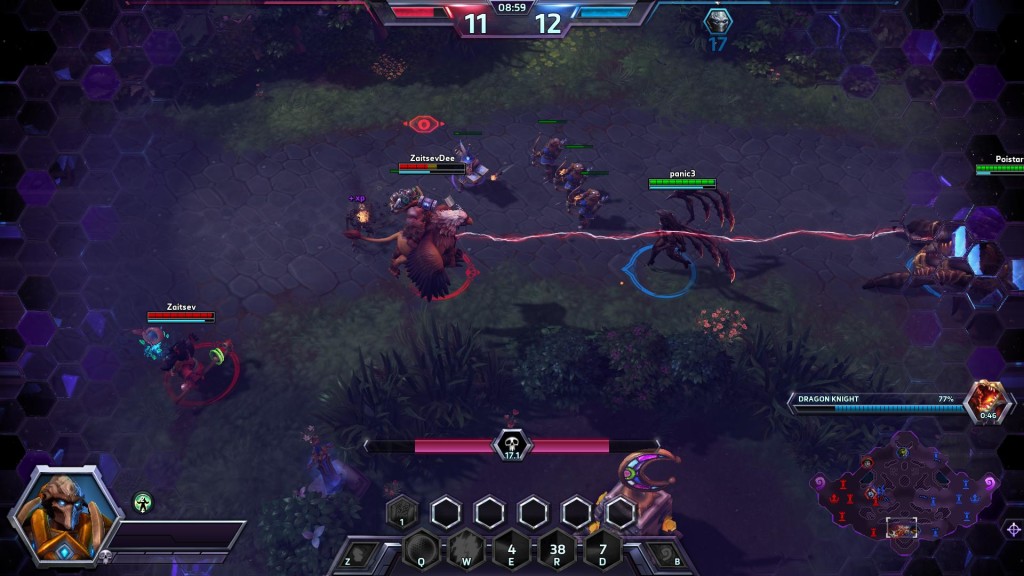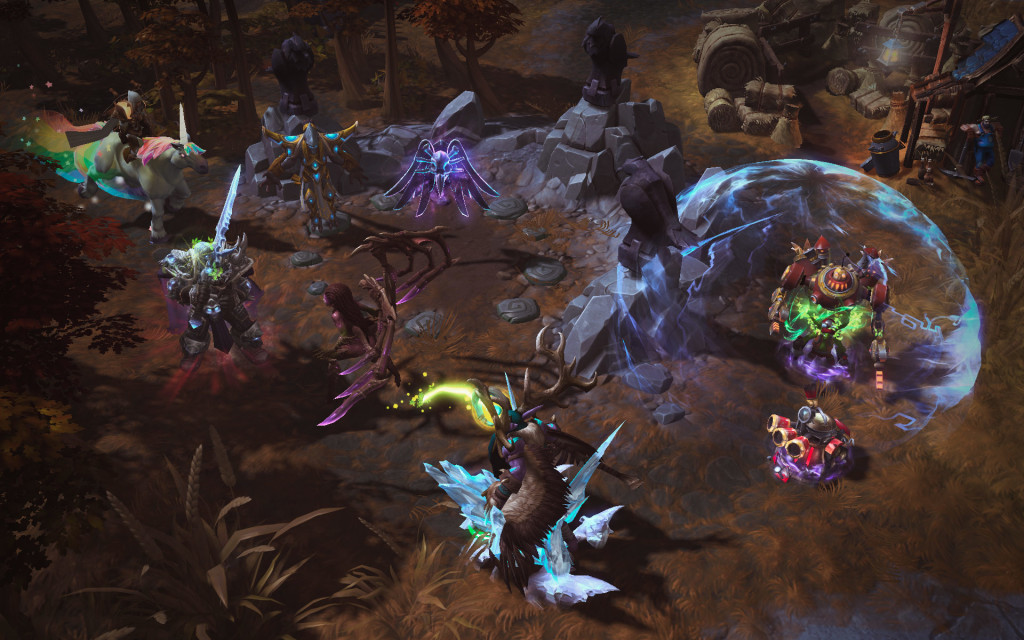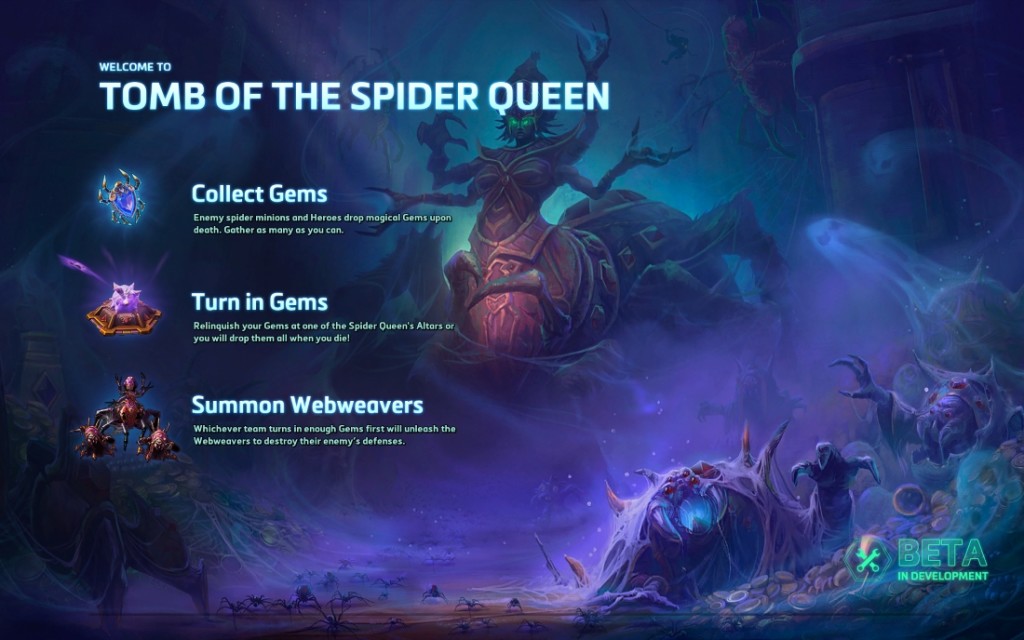Heroes of the Storm is the best game in its genre, hands down.
There are several reasons for this. Blizzard, like they often tend to do, take a pre-existing genre template, figure out what went wrong in its design to make it inaccessible, and thereby tailor a well-worn success among hardcore gamers towards the broadest mainstream limits. That, in a nutshell, tells you exactly what Blizzard did with MOBAs and Heroes of the Storm. Originally a modification for WarCraft III, they surpass the efforts of the modding community and other companies through a few basic principles:
1. Heroes remains intuitively “fun” to play. The learning curve for understanding Heroes takes place within a tutorial which takes all of 20-30 minutes. As a person who played ARPGs and understood the genre in advance, I’d say it took all of ten minutes to figure out what to do. Basic controls feel completely natural and the default abilities of your Hero (all of four, sometimes a few more) take little time to understand and learn. It doesn’t hurt that every hit sounds and feels satisfying (much credit to the graphics and sound for this). The addition of map objectives (more on that later) makes it easy to understand the basics, since it focuses the game on specific points of the map so you know what to do. Everything just makes sense just from playing the game, which is far more than can be said for its contemporaries. If you want to start anywhere in this genre, start here (though I doubt you’ll want to leave).
2. Heroes cleanses the genre of “false complexity”. Concepts such as jungling (farming mobs in the middle of the map), itemization (i.e., jamming an RPG with in-game shops into an action game), last-hitting (a dumb mechanic which requires timing to gain gold and experience to use in said shop), laning phases (i.e., spending 30 minutes attacking enemy mobs in the most boring way possible before the “real” game begins), and the like utterly disappear. In their place comes a competitive atmosphere that hits the ground running from the moment the game starts. Yes, there’s still a phase where players need to soak experience in the two/three lanes on hand, but gaining and depriving experience proves to create a strategic element to the early game that gives the game a sense of pacing. Almost everything cut felt completely extraneous from the start, no matter what LoL or DOTA diehards will say.
3. In other words, Heroes skips right to the exciting parts: team battles! No prep time required! Heroes demonstrates a sense of immediate danger as you try to figure out how the enemy composed their lanes, and how to respond accordingly. A single hero doesn’t stand a chance again a lane with two or more unless he’s really paying attention and doesn’t act stupid. Sometimes, the game breaks into all-out war right from the get-go; while, perhaps, this doesn’t represent the best tactical decision, it is a lot of fun! Games take anywhere from 20-30 minutes maximum; in effect, due to this short length, every action actually causes something in the game to shift. That makes your actions important, and less “grinding towards eventual fun”.
4. Furthermore, Heroes switches up match-to-match mechanics with seven different maps (with more to be added in the near future). Each one contains a new game-changing mechanic – say, summoning a giant monster for your side, or a curse on the other team – for the collection of some resource. As you might suspect, both teams will strive to obtain these objectives for the advantage they provide, and thus more team battles happen! Things can shift on a dime, and you must adapt to the changing circumstances of the map at any one point. You must juggle many things, from soaking experience from lanes to ensuring your teammates don’t die to obtaining optional mercenary camps. As well, you must know when to push a lane towards the base to snowball the game into a win state. That sort of multi-tasking sounds boring, but somehow actually works!
5. Lastly, Heroes contains what I would call an inordinate amount of teamwork (see: the aforementioned focus on team battling). A single Hero will almost never shift the tide in one team’s favor. A single Hero can never win against a team of two in literally any circumstance I encountered while playing. Even with an experience advantage of 3 levels or more, you simply cannot fight two Heroes alone and expect to live (especially, say, in an open area with little chance of escape). Heroes of the Storm wants you to work as a team at all times. This lessens the individual contribution of members so that one party member cannot gather all the experience and push by virtue of their extreme experience advantage. The shared experience pool forces everyone to work together, or die trying.
And really, you never want to die. Dying in Heroes will always cause a major disadvantage for your team, not only in travel time back to your original position. The game always announces these deaths AND shows how long it will take for allied and enemy Heroes to spawn, meaning the other team can set up an ambush or create an advantage in the time frame until your resurrect. As well, you miss out on essential experience which could, in the long run, spell the end of the game.

In fact, the only real way to play Heroes of the Storm involves playing with people you meet or know in the game. Each and every Hero, while containing their own individual attributes, can contribute much to wiping out the opposite team via stuns, heals, silences, or various other abilities which can shut down the opposition. A combination of several Hero abilities (learned at level 10) chained in sequence during an ambush can spell the doom of your opponents in about ten seconds. While it won’t put them out of the game forever, it does create an advantage, however slight, and cascading advantages are the name of the game.
Yes, the game intentionally “rubber-bands” in this way so that your grasp on the lead feels tenuous, but this seems to me a fair compromise to create an exciting, accessible, and ultimately fun entry into this genre. At least it comes no where close to Mario Kart’s Blue Shell in terms of shifting the game’s winner. It still requires skill to win, and coordination with four other people to stand a decent chance to win. I don’t think I have ever played a game that, by design, requires complete coordination to succeed. Nobody gets to go it alone, and if you do, you might just get ganked. You must work together, or fail.
While I would’t call it a perfect game due to the genre’s natural problems and arbitrary structure, this unwavering focus on teamwork makes most people friendly in a way these games rarely promote (or, in fact, most video games in general). In higher ranks, you can’t pick duplicates; you need coordinated teams of Heroes with complementary abilities. Since everyone needs to work with each other, in-fighting has no place, nor do you need it. Nobody gets blamed, for the success or failure of all usually rests on the execution of everyone in concert, not via one lazy person. In a strange way, it best represents what the author of Ecclesiastes meant in Chapter 4:
9 Two are better than one because they have a good return for their labor.10 For if [either of them falls, the one will lift up his companion. But woe to the one who falls when there is not another to lift him up. 11 Furthermore, if two lie down together they keep warm, but how can one be warm alone? 12 And if[f]one can overpower him who is alone, two can resist him. A cord of three strands is not quickly torn apart.
In our case, we need to extend it to five Heroes, but the more the merrier, right?


